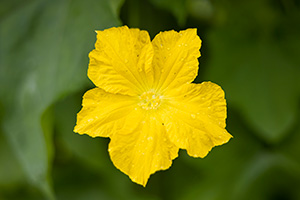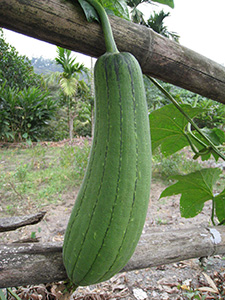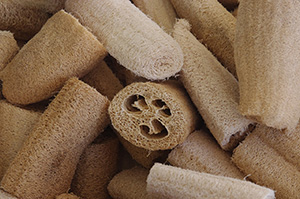Luffa

Luffa is a unique summer squash that is useful as both an edible and a sponge. The vining plant grows fruits that can be eaten raw or cooked when young but become large and fibrous once mature. Mature fruits can be peeled, dried and deseeded to be used as biodegradable sponges for personal care or cleaning.
Characteristics
There are two types of luffas that can be grown in Florida, angled luffa (Luffa acutangula) and smooth luffa (L. aegyptica). Both species grow similarly to cucumber, with lobed, hairy leaves that sprout from climbing vines. The leaves are fragrant when crushed. Pollinators frequent the yellow flowers that appear.
The smooth luffa produces fruits that look like large cucumbers. They grow to be up to one to two feet long and four to five inches thick. Angular luffas look similar, except they are darker in color and have sharp ridges running lengthwise down the fruit. Both fruits are cucumber-like inside when immature, but then become fibrous with many flat, black seeds.
Commonly found smooth cultivars include ‘Smooth Boy’, ‘Smooth Beauty’, and ‘South Winner’. For angled luffas, try growing ‘Lucky Boy’, ‘Hybrid Green Glory’, ‘Summer Long’, and ‘Hybrid Asian Pride’.
Planting and Care

The ideal soil for growing luffas is neutral to slightly alkaline with high moisture and good drainage. The stems can grow up to 30 feet, so trellises are necessary to support the vines and encourage straighter fruit. Vertical trellises six feet or taller are ideal. You can also grow luffas in containers that are between two and five gallons.
Luffa can be planted through direct seeding or transplanting. If you are starting from seed, wait until the plants have two to three true leaves before transferring them to your garden. Once you’ve established a planting location, space your seeds or transplants three feet apart. Rows should have six feet between them.
UF/IFAS has not developed specific fertilizer recommendations for luffa yet, so the instructions for cucumber should be used as a guide. We recommend that gardeners apply a balanced, slow-release fertilizer when necessary. A soil test can confirm if your soil has any nutrient deficiencies.

The main pest you may encounter is leafminer. Fruit rot is also a problem if fruit is touching the ground; apply mulch around the plants to help prevent it. If you spot signs of pest or disease problems, contact your county Extension office for help.
Luffa is a warm-season vegetable, so plant seeds from March through July in a full-sun location with well-drained soil. The stage at which you should harvest your luffas depends on their intended use. If you’re interested in eating them, then harvest the squashes when they are less than six inches long. They can be eaten raw or prepared as you would other squashes. For sponges, harvest luffas once they are fully matured, with green or brown skin that is pulling away from the fibers within.
Luffa Sponge Tutorial
You’ve harvested your luffas, but how do you turn them into sponges?
Start by snipping one end of the luffa to create a hole. Then, use your clippers to cut from the opening down to the other end of the luffa, making a lengthwise opening. Open the luffa at the seam and pull the husk away from the fibers. If your luffas are not peeling easily, try soaking them in water for a couple of hours to a day or two to help loosen them before peeling.

To remove the seeds, tap the luffa over a bowl or bucket. The seeds should easily dislodge and fall into the bowl. Spread the seeds out on a sheet for a couple days to let them dry before storing them for next season.
Next, rinse the luffas until they are clean. If there are any unattractive spots on your sponges, you can either soak them in a bleach solution or spot-treat the problem areas until they are uniform.
The final step is to lay your sponges in the sun until they’re completely dry. That’s it! Now you have sponges that will store for years and can be simply tossed into your compost pile once you’re done with them.
